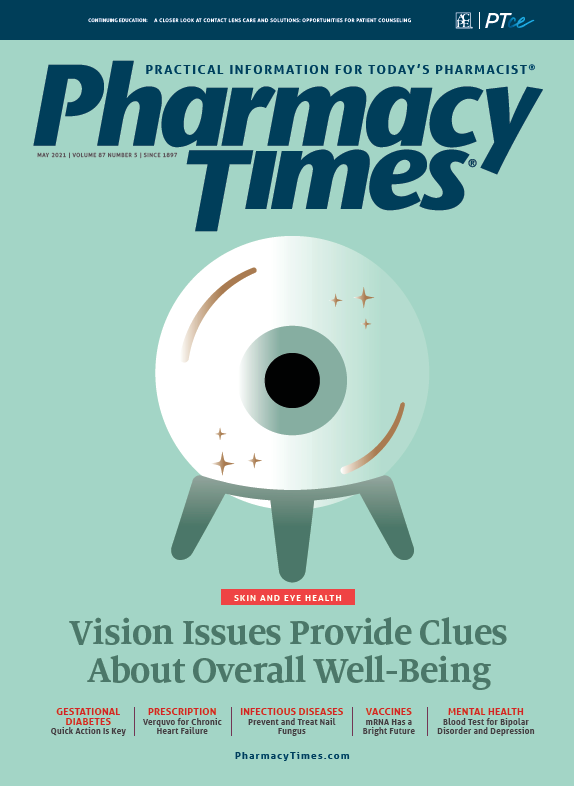Publication
Article
Pharmacy Times
OTC Case Studies: Eye Infections
Case studies include recommendations for eye pain and allergy relief.
CASE 1: DRY EYES
Q: ML is a 38-year-old woman who has had pain in her eyes for approximately 1 week, with no other issues. She says she feels as if she has something in her eyes, like sand. Upon inspection, ML's eyes look normal with no discoloration. She does not take any medications. What should the pharmacist recommend?
A: Dry eyes typically appear normal. However, patients often complain of a gritty, sandy feeling in their eyes. Allergens and anticholinergic medications can often cause or exacerbate dry eyes. Mild to moderate disease can be treated with OTC lubricants. One class of medications is substituted cellulose ethers, which include carboxymethylcellulose and hydroxypropyl methylcellulose.1 Other ingredients, such as carbomer polymers, glycerin, polyethylene glycol, polyvinyl alcohol, providone, and propylene glycol may be added as inactive ingredients to help with lubrication and viscosity. Gel formulations have higher viscosity and may be more beneficial for moderate disease. Newer OTC combination agents to not only lubricate eyes but also protect against evaporation of natural tears and provide a barrier to prevent loss of the aqueous component of the tears. Because ML has only had dry eyes for a short time, she may benefit from trying an OTC treatment containing caboxymethylcellulose and hydroxypropyl methylcellulose. ML should follow package directions because these can vary, depending on the product.
CASE 2: ALLERGIC CONJUNCTIVITIS
Q: GG is a 27-year-old man seeking a treatment for his seasonal allergies, which have caused itchy eyes for the past 2 weeks. He takes loratadine 10 mg daily but has been playing golf frequently and thinks pollen is causing the itchiness. GG is looking for a short-term solution until the pollen count decreases. He takes no other medications and has no other symptoms. What should the pharmacist recommend?
A: Ideally, GG should try to avoid pollen or decrease exposure to it, because it triggers the itchiness. He can also try applying cold compresses, washing his eyes out with water when he goes indoors, and wearing sunglasses outside to reduce the itching. First-line treatment for allergic conjunctivitis is artificial lubricants such as carboxymethylcellulose and hydroxypropyl methylcellulose.2 These agents can help wash out allergens and relieve symptoms. If symptoms persist, GG can use mast cell stabilizer, ophthalmic antihistamine, or histamine receptor H1 antagonist products such as ketotifen fumarate or olopatadine. Because he is already taking an oral antihistamine, he should be evaluated if symptoms do not improve within 72 hours. Other antihistamines or nasal corticosteroids may also help GG.
CASE 3: CONTACT DERMATITIS
Q: NM is a 19-year-old woman complaining of redness and swelling along her eyelid for the past 48 hours. She does not feel any pain. NM just returned from a spring break trip. She started using a new eyeliner while she was away but otherwise has not used any new cosmetics, lotions, or soaps. What is the best treatment strategy for NM?
A: NM may be suffering from contact dermatitis from her new eyeliner. The best treatment strategy is to discontinue using the eyeliner and see if symptoms resolve. If the redness and swelling continue, NM can try OTC diphenhydramine. She can also apply cold compresses 3 to 4 times per day. Advise NM that cleaning her eyelids with warm water and a washcloth may be beneficial. If symptoms persist, she should be evaluated. Other topical agents, such as calcineurin inhibitors or corticosteroids, can be used for contact dermatitis of the eye. Some study results suggest that corticosteroids may be more beneficial, but NM should consult with a health care professional before beginning treatment.3
CASE 4: EYELID INFECTION
Q: YU is a 48-year-old man complaining about eye pain. His eyes appear red with inflamed lids. YU has discharge every morning from his eyes that makes opening them difficult. He says he suffers from seasonal allergies. YU has been taking cetirizine hydrochloride and mometasone furoate nasal spray daily and the past few years during allergy season. During bad allergy seasons, he gets repeated sties. Last week, YU had another stye and his physician recommended using warm compresses to get rid of it. But this is the first time YU has had an inflamed lid. What recommendations can the pharmacist give him?
A: YU appears to have an eye infection. Potential symptoms include matting of the lashes; ocular discharge; red, thickened lids; and scaling. YU should see a physician to rule out a bacterial or fungal eye infection. In addition, good eyelid hygiene can help combat frequent sties.4 Advise YU to clean his eyelids by first washing his hands and then moistening a clean cotton swab or washcloth with a cleaning solution recommended by his physician or with water. He should gently wipe his eyelashed and lid margin on both eyes and then wash them out with warm water.5
ABOUT THE AUTHORS
Rupal Patel Mansukhani, PharmD, FAPhA, NCTTP, is a clinical associate professor at Ernest Mario School of Pharmacy at Rutgers, The State University of New Jersey, and a transitions-of-care clinical phramacist at Morristown Medical Center in New Jersey.
Ammie J. Patel, PharmD, BCACP, BCPS, is a clinical assistant professor of pharmacy practice and administration at Ernest Mario School of Pharmacy at Rutgers, The State University of New Jersey in Piscataway, and an ambulatory care specialist at RWJBarnabas Health Primary Care in Shrewsbury and Eatontown, New Jersey.






